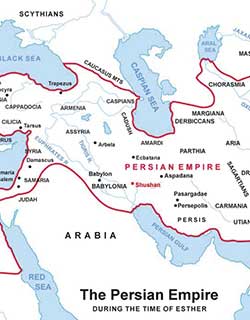This article appeared in:
Part 1 of the Series:

Esther, the seventeenth book of the Bible, records the attempted mass destruction of the Jews exiled in the vast Medo-Persian Empire (see map).1 This was prevented by the actions of Mordecai, a Jew, and his cousin, Esther, who had become Queen. At great personal risk, Queen Esther successfully appealed to the despotic King Ahasuerus on behalf of the Jews.
The inclusion of Esther in the Bible has often been questioned because there is no reference to God nor the worship of God in the book. That said, it records the faithfulness of God towards His people in their darkest days. While He is hidden from view and is apparently silent, His control of events is seen throughout. This alone warrants its inclusion in the Bible, and our study of it.
This underlying theme is set against the backdrop of a satanic plot to destroy God’s chosen people, the Jews. It is through the nation that the promised Saviour will come. Satan is moving yet again through human agency to stop that, by orchestrating the annihilation of the Jews, Esther 3. 13.
However, we will see God’s hand in events to halt this wicked plot. Esther teaches us that God is never taken by surprise. Rather, the opposite is true. We see that He moves in advance of events, as sovereign over His creation, to fulfil His own plans and purposes.
There are, of course, many examples of this in the Bible. Do you remember when Joseph revealed himself to his brothers, Gen. 45. 7, 8? He recognized that he had been placed in Egypt in advance of the famine, so that God’s people would be preserved.
So, as you read, look out for, and think about, the following actions of God as He moves silently in advance of events, to protect His people.
The events in Esther take place during the times of the two preceding exilic books, Ezra and Nehemiah.
Ezra focuses on the rebuilding of the temple, and Nehemiah on the repair of the walls of Jerusalem.
But in Esther the Jews apparently lack any ambition to return from exile. Instead, they seem to be far from God in heart, and unfaithful to Him. Even so, God does not change and remains faithful to them. He will act to preserve them from mortal danger.
The events occur in the Medo-Persian Empire when Ahasuerus III, also known as Xerxes I, was king (486 to 465 BC). This is the second world empire, following the Babylonian Empire, as represented by the silver breast and arms of the image seen by Nebuchadnezzar in Daniel chapter 2.
The first verse tells us that the empire stretched from India (the river Indus) to Ethiopia. Ethiopia was the name used by the Greeks for the border area between present-day Egypt and Sudan.
In Part 2 we will look at the principal characters in this fascinating book.
| Cookie | Duration | Description |
|---|---|---|
| cookielawinfo-checkbox-advertisement | 1 year | Set by the GDPR Cookie Consent plugin, this cookie is used to record the user consent for the cookies in the "Advertisement" category . |
| cookielawinfo-checkbox-analytics | 11 months | This cookie is set by GDPR Cookie Consent plugin. The cookie is used to store the user consent for the cookies in the category "Analytics". |
| cookielawinfo-checkbox-functional | 11 months | The cookie is set by GDPR cookie consent to record the user consent for the cookies in the category "Functional". |
| cookielawinfo-checkbox-necessary | 11 months | This cookie is set by GDPR Cookie Consent plugin. The cookies is used to store the user consent for the cookies in the category "Necessary". |
| cookielawinfo-checkbox-others | 11 months | This cookie is set by GDPR Cookie Consent plugin. The cookie is used to store the user consent for the cookies in the category "Other. |
| cookielawinfo-checkbox-performance | 11 months | This cookie is set by GDPR Cookie Consent plugin. The cookie is used to store the user consent for the cookies in the category "Performance". |
| elementor | never | This cookie is used by the website's WordPress theme. It allows the website owner to implement or change the website's content in real-time. |
| viewed_cookie_policy | 11 months | The cookie is set by the GDPR Cookie Consent plugin and is used to store whether or not user has consented to the use of cookies. It does not store any personal data. |